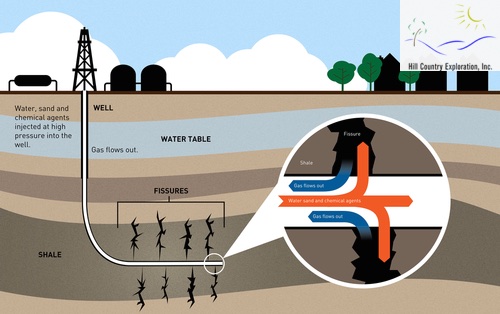Reservoirs contain large quantities of oil and gas, but much of it is unreachable through traditional drilling techniques. One of the latest improvements in well drilling is oil and gas fracking. This method of shale oil fracking can tap into a larger portion of the reservoir, particularly in shale, coal beds and tight sands. Fracking helps stimulate the well and improves the flow of oil and gas out of the well.
Drilling Differences
Oil well fracking doesn’t start off any differently than any other type of well. The oil and gas company drills straight down to the shale where the oil reservoir is located. Steel casing tubes are then inserted into the drilled well to give it more stability and decrease the risk of a cave in. However, unlike a traditional well, perforations are made into the casing at the shale reservoir level. Instead of pumping the oil and gas up through the well, fracking fluids are injected under pressure through the casing. These liquids cause cracking in the shale, giving the oil and gas more openings to flow through to the surface.
What Materials Are Used?
In the process of oil and gas fracking, a specific mixture is used to create the fracking fluid. A large portion of this fluid is water, but it is also mixed with proppants and chemicals. While much of the water returns to the surface and is typically recycled by the oil and gas companies, the proppants remain under the ground to help hold the fractures open to ensure the smooth flow of oil and gas. In some situations, propane or nitrogen may be used to help remove the debris that could be present in the fractures. Acidizing can also be used to enlarge the fractures and increase the flow of oil and gas from the reservoir.
Environmental Concerns
Any time foreign substances are introduced into the ground, there are environmental factors to take into consideration. Some of the materials used in shale oil fracking may be left behind. However, much of these materials are out of the reach of ground water and other areas where humans may be exposed. In addition, the water used in fracking is often recycled, reusing it for additional fracking or other similar purposes. While the long-term effects of oil well fracking are still relatively unknown, they are thought to be safe enough to continue using to keep production numbers up.
Oil and gas fracking is one of the newest drilling techniques used by oil and gas companies in the United States. This process makes it easier to obtain these materials from wells that would otherwise remain untapped or could cost a large amount of money to make the well profitable. This oil well fracking process has increased production numbers and helped the United States become one of the top oil producers around the world.
If you’re interested in investing in oil and gas wells, contact us. We have a strong portfolio of wells across the country to help you make smart investment choices.




